In 2018 Steve Corica was appointed as the head coach of Sydney FC with the tough job of succeeding in Garnham Arnold’s successful passage. The former Sky Blues player previously served as assistant of Arnold and as the National Youth coach for the club to earn this position. This year the Sky Blues have claimed the Premiership with four games to spare, being in good shape to become back-to-back grand final champions.
In this tactical analysis, we will develop Steve Corica’s philosophy depicted in the Sky Blues style of play analyzing all the phases of their game in their first 22 games that awarded them with the silverware in anticipation. This analysis will cover in deep Corica’s offensive 4-2-2-2 formation and tactics, involving patterns and off the ball movements to vertically progress the ball.
In-Possession Structure through the thirds
The Sky Blues shift their shape when in-possession to gain a positional superiority that allows them to progress the ball out from the back fluently, starting in a 4-2-2-2; formation mastered by Ralf Rangnick at the Bundesliga. The defensive line is in charge of progressing the ball, with the help of the two pivots who offer inwards options to break the first line of pressure. The pressing style of the opposing team will define the number of players used for their build-up, using one more player than the opposition to break the first line of pressure.
When rivals display a medium-block waiting at the edge of the middle third, we start seeing Corica’s positional style. In these situations, the ball-side pivot will drop deep either in between or at the side of the centre-backs, creating a back-three, allowing the full-backs to position higher, creating a 3-1-4-2 formation. The pivot who drops deep would be the one in charge of progressing the ball from the back, gaining quality in the distribution. This shape creates a platform to penetrate the mid-block using different options. In the following picture, we can see the positional advantage created with the rotation breaking the layers of the opposition defensive structure. The opposing defensive-midfielder jumped in the first line allowing the weak-side pivot to give an option between the first two lines. With the forwards stretching the defensive line, the full-back and advanced midfielders position themselves between the second and third lines of pressure, giving more advanced options.
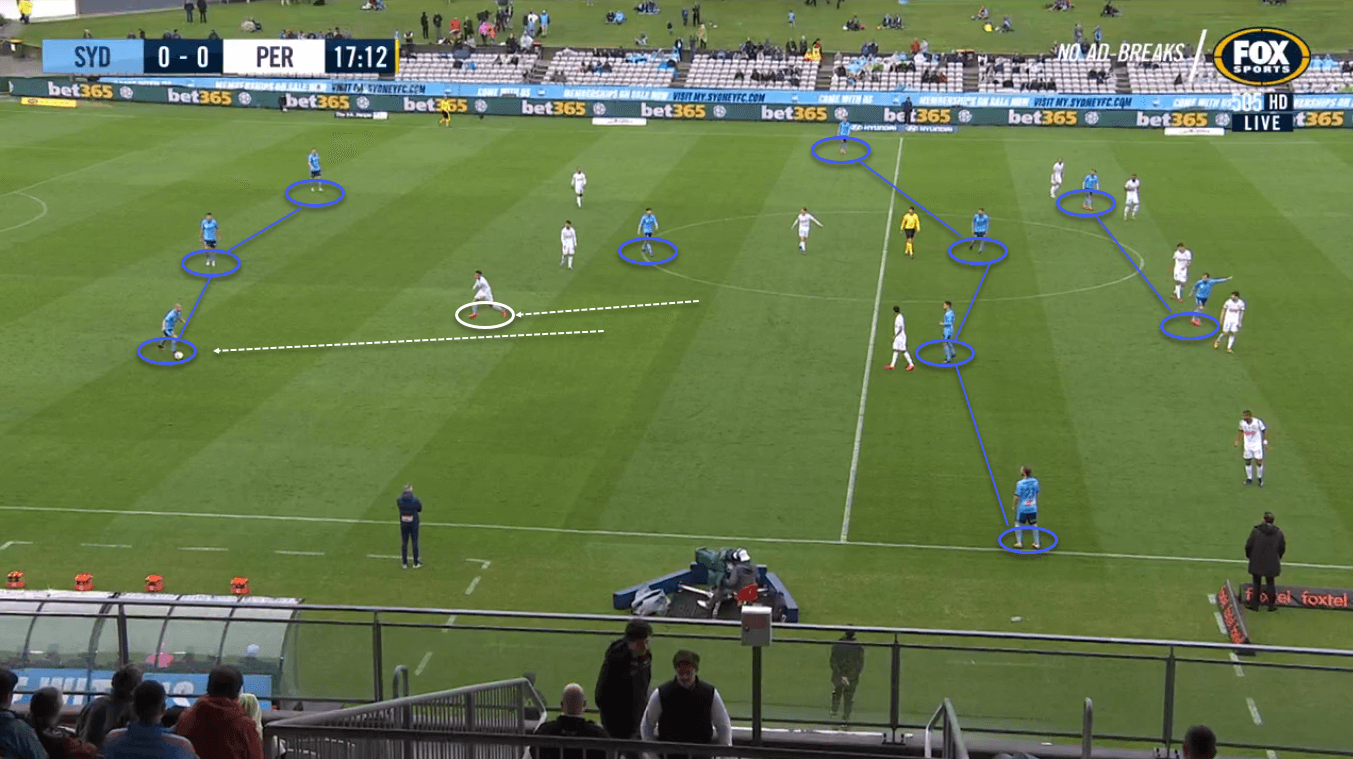
Corica’s style of play will give the team freedom when progressing the ball in the middle third, and the 4-2-2-2 shape will be left aside to create as many triangles and diamond structures as possible gaining in combination play. Their positional game positions them first in having the least amount of losses in the A-League, averaging just 88.32 losses per 90 minutes, with the league average being 94.65 losses per minute.
The five lanes will be covered, not accumulating more than two players on the same channel, keeping different highs creating gaps in the opponent’s structure. In the next shot, the Sky Blues structure is shown, with the ball in the left flank of the middle third carried by the full-back, the strong side forward will give a forward option in the wide channel. Both in the half-space, the centre-back and the advanced midfielder dropped, providing support backward and horizontally, respectively. Both pivots formed the second line of options staggered on the edge of the central channel. Another thing to highlight from this structure is the far side forward stretching the centre-backs and the weak-side advanced midfielder keeping a wide position staying isolated on the right side.
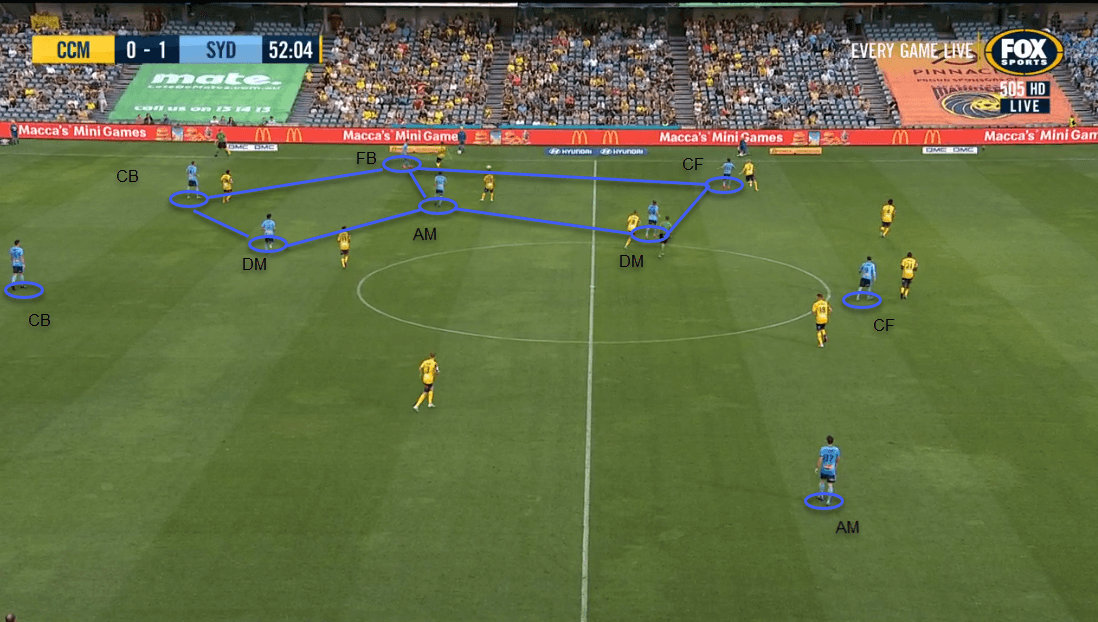
At the final third, the Sky Blues will exploit the different channels to break the defensive line in an attacking-minded shape, either a 2-2-4-2 or 2-2-2-4 formation. Scoring 46 goals in 22 games Corica’s aggressive style is deployed, with an average of 2,09 goals per game ranking first in the A-League. With the double-pivot giving support in-front of the backline, the full-backs will take higher positions either in-line with the advanced midfielders or even higher joining the forwards line. The full-backs are instrumental in giving width to the team, with the striking duo committing the defensive line to provide a positional advantage for the advanced midfielders who play in front of the defensive line.
The Sky blues will overload the final third, arriving in times with up to six players to the box. In the next picture, we can see this in action, with the two full-backs coming into the final third, the two strikers challenging the cross, and the advanced midfielders supporting from behind. With this positional style of play, Sydney FC manages to attack with a numerical superiority creating an overload inside the box.
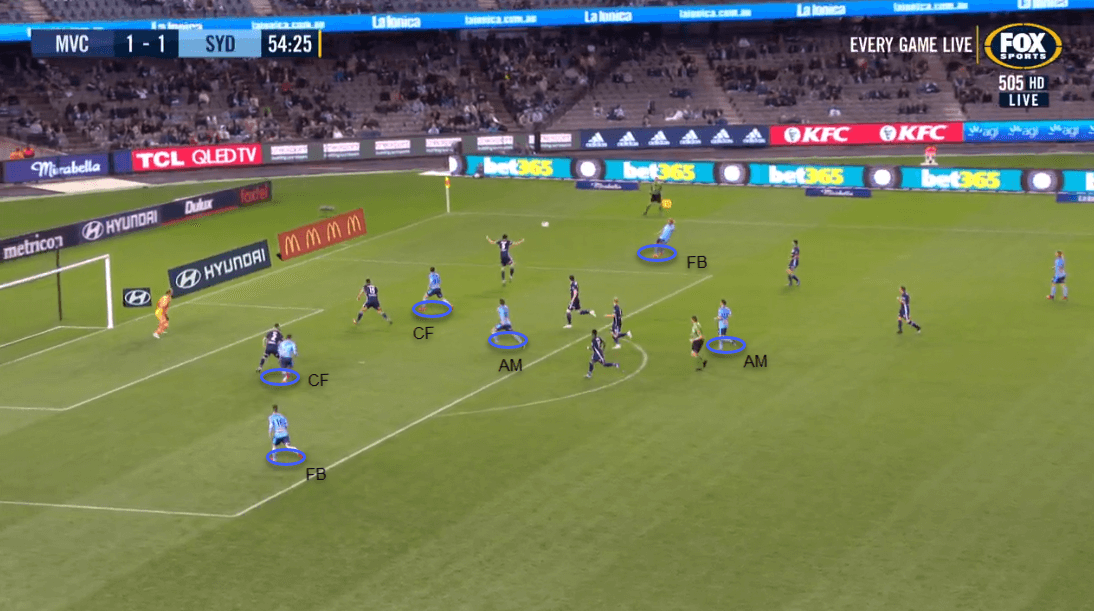
Attacking tools to progress the ball
When in-possession, we can see the offensive philosophy of Corica, creating a team with high cohesion with the primary objective of getting the ball in the advanced positions. This style of play has taken the Sky Blues to be the team with the second-highest xG (38,61 in 22 games), only outperformed by Adelaide United (41,37 xG). We will analyze next their off the ball movements and patterns to penetrate the lines as Corica’s style prefer the vertical penetration, just averaging 50,5% of ball possession.
The 4-2-2-2 offensive formation used by the Sky Blues favors the up-back-through (U-B-T) pattern to penetrate the lines centrally. This structure overloads the central area with three pairs of players staggered in between the rival lines: defensive-midfielders, advanced-midfielders, and centre-forwards (DM-AM-CF). In the next picture, we can see this penetration taken part in the middle third, combining the CF with the DM lines. The strong-side forward drops to pick up the pass from the wide area, with the ball-side DM positioning looking forward to receiving the lay-off. The last part of the movement ends with a through ball of the DM to penetrate the defensive line and connect the weak side CF who has run into space. Under this movement, the Sky Blues penetrate the opposition centrally, engaging the defender to follow the drop back movement creating space behind. There should be a third man run to exploit the space created behind the lines.
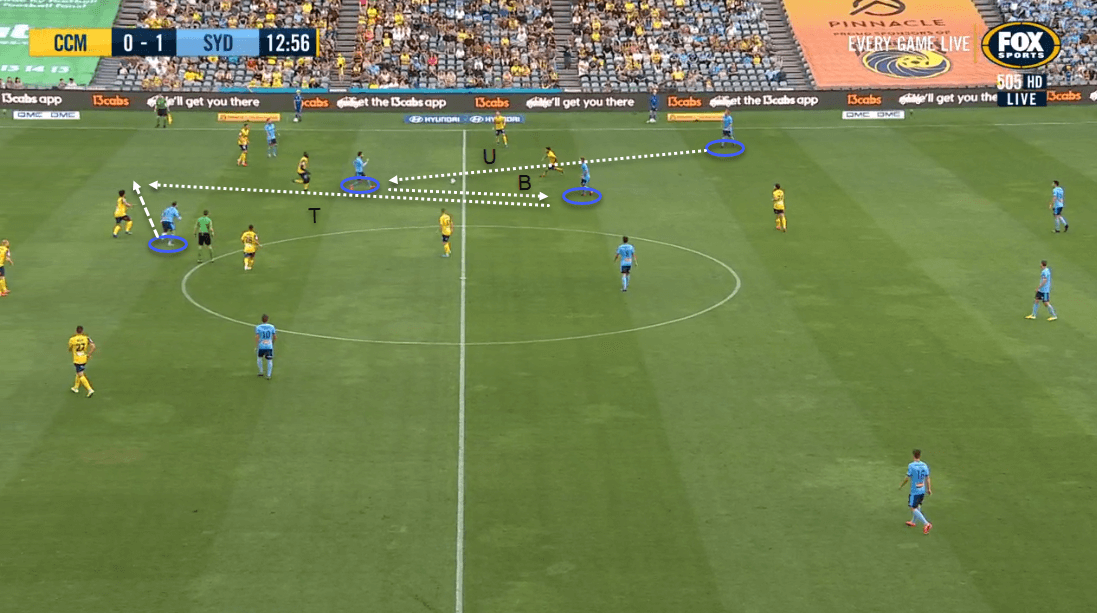
To progress the ball through the flanks, we can see wide rotations between the full-backs and the advanced midfielders. This inside-outside rotation is depicted in the following picture, with the right full-back positioning in the half-space receiving the ball in behind the midfield line. The advanced midfielder creates space dropping wide, committing three players. This rotation, as a result, enables Corica’s team to progress up through the half-spaces; the opponent midfield line is in a dilemma whether to press the playmaker who has to drop wide opening gaps or to stay compact, enabling the playmakers to receive with space.

Another non-verbal communication displayed by the Sky blues under Corica’s style is the Out-In-Out (O-I-O) movement, shown in the next shot. The advanced midfielder will start high, provoking the full-back to follow him as he drops into the half-space, in a position he would also commit the rival’s wing-back. The ball is passed from the central area out into the left half-space with the two wide rivals jumping in to defend the ball. The second part of the movement involves an inside pass to the central midfielder, who plays out again into the space created. The full-back is, in this case, doing the third man run to receive the ball out wide and penetrate the lines.
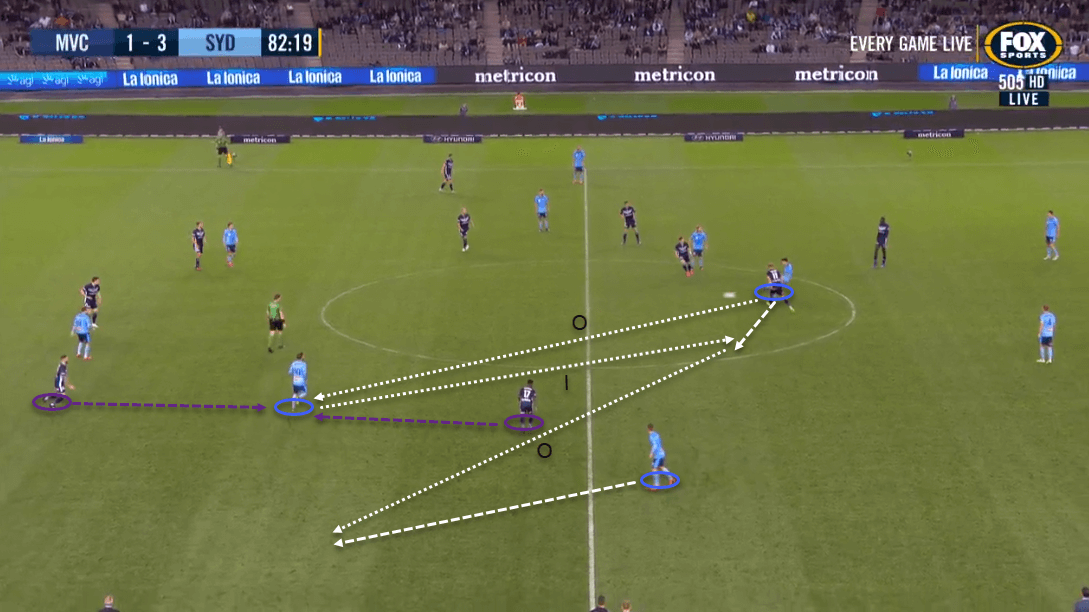
Last but not least, another pattern used by the Sky Blues to advance through the thirds is using the full-back in the weak-side. As aforementioned, both full-backs will have a high and wide position when progressing the ball through the thirds, with the advanced-mid and the centre-forwards overloading the strong side committing rivals to one flank. In the next picture, we can see this movement in action, with the defensive-midfielder having a spatial awareness, switching the ball to the weak full-back (not appearing in the shot), who exploits his isolated positioning in the final third.
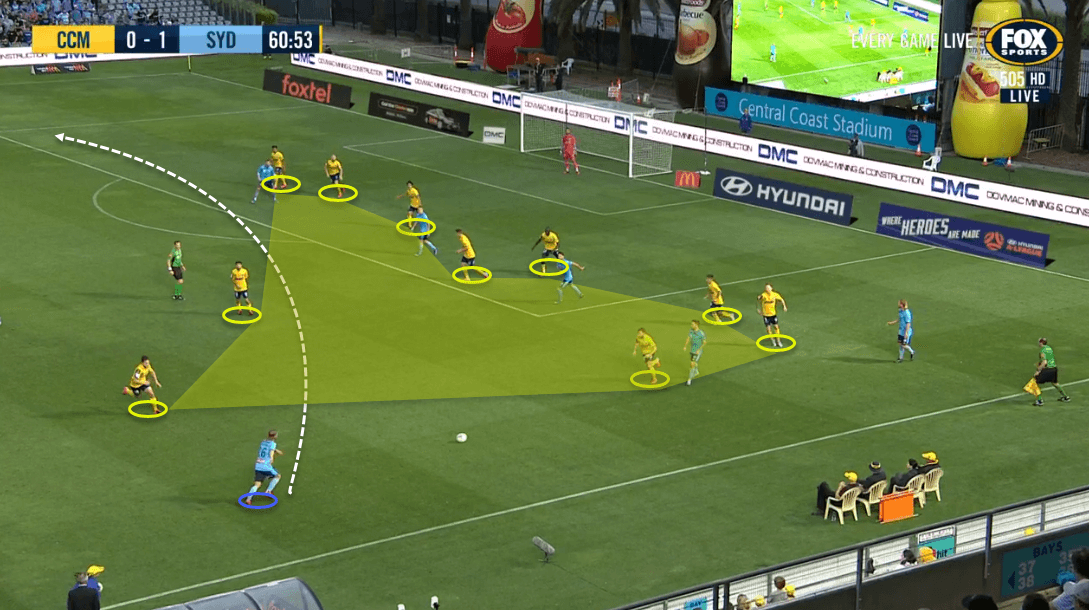
Defensive Style
Defensively Corica structures the team in a classic 4-4-2 shape with the advanced midfielders withdrawing as wing-backs. Corica’s defensive style also shows work and cohesion being the team that conceded the least amount of goals in the season (19 in 22 games), conceding an xG of 28,1 outperformed only by Perth Glory (25,2 xG against). The Sky Blues use a mid-block waiting for the opponents at the edge of the midfield third and dropping back into a compact low-block once the rivals progress the ball. With a PPDA of 13,12, they rank second-last in the pressing intensity in the A-League, accounting for 50% of their recoveries in their defensive third.
In the mid-block, the two centre-forwards would position centrally cutting off any possible forward passes, and the advanced mid will stand on the half-spaces blocking the wide play and ready to press if the centre-backs tends to dribble forward. In the next picture, we can see this mid-block structure with the two strikers positioned in the central area, and the strong side advanced mid, scanning the rival’s full-back and shadowing him. If the centre-back decides to drive forward, the advanced back will curve his press shadowing the full-back and will receive the inside support of the centre-forward creating a two-v-one. Otherwise, if they decide to play centrally into the pocket, the Sky Blues will quickly pressure setting a trap.
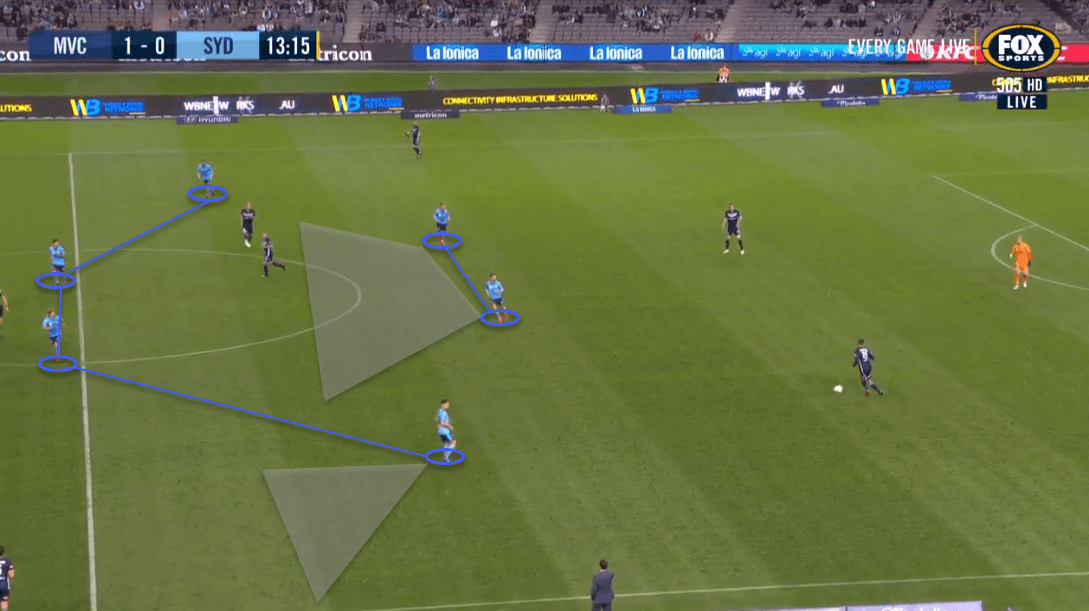
If rivals manage to progress the ball, the Sky Blues will retreat into a compact low-block. The main characteristic of Corica’s defensive philosophy is keeping the defensive compactness, both horizontally and vertically. The Sky Blues defensive compactness gave them a spatial control in the central area, applying a defensive overload in it. This numerical superiority allows short distances to be kept between the players, reducing the passing lanes, and giving more defensive access to press the ball carrier. On this defensive low-block, the Sky Blues used a space-oriented man coverage, while this kind of coverage is still under the threshold of man-marking, we can say that this one is a hybrid between man and zone coverage. Under this kind of marking, they keep the compactness and, at the same time, pressure the opponents that enter into their coverage zone with the ball.
In the next picture, we can see the compactness of the Sky Blues with all the lines within the width of the box and occupying an even shorter length vertically. We can also see the space-oriented coverage; as the defensive midfielder quickly presses the ball carrier, which enters into his coverage zone, reducing his time and space with all the team keeping the defensive compactness. The defensive-mid will drop back when the ball is out of the coverage zone keeping the vertical compactness. Even though rivals could position themselves in between the lines with no personal mark, if they received the ball, the Sky blues will quickly press them, creating a defensive overload due to the short distances to cover in this compact block.
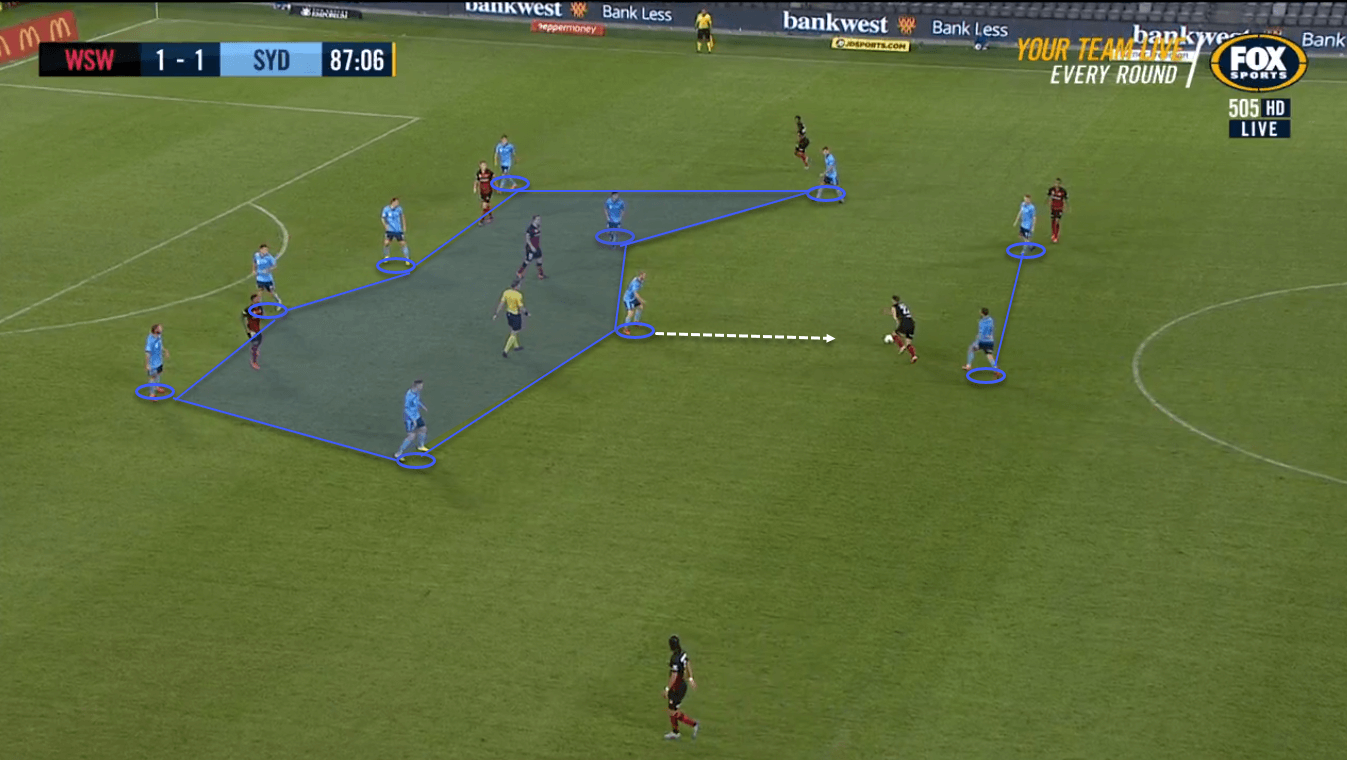
Corica’s defensive style blocks the central areas forcing the opposition to play wide; once this occurs, the team will slide compactly to the flank. The Sky Blues defend with the advanced midfielders’ who lack defensive attributes, albeit under this compact structure their defensive weaknesses are overcome being supported by team-mates who cover them. Corica’s strategy in the defensive third is overloading the box, reducing the danger if the opposition managed to cross the ball. This defensive numerical superiority works due to the vertical compactness of the team, which allows more players to arrive at the defensive positions. In the next picture, we can see the defensive structure of the Sky Blues when the ball is forced wide. Two players support the press of the advanced midfielder having access to the ball carrier if he managed to skill the wide pressure. We can also see the defensive overload inside the box with three other midfielders at the edge of it.
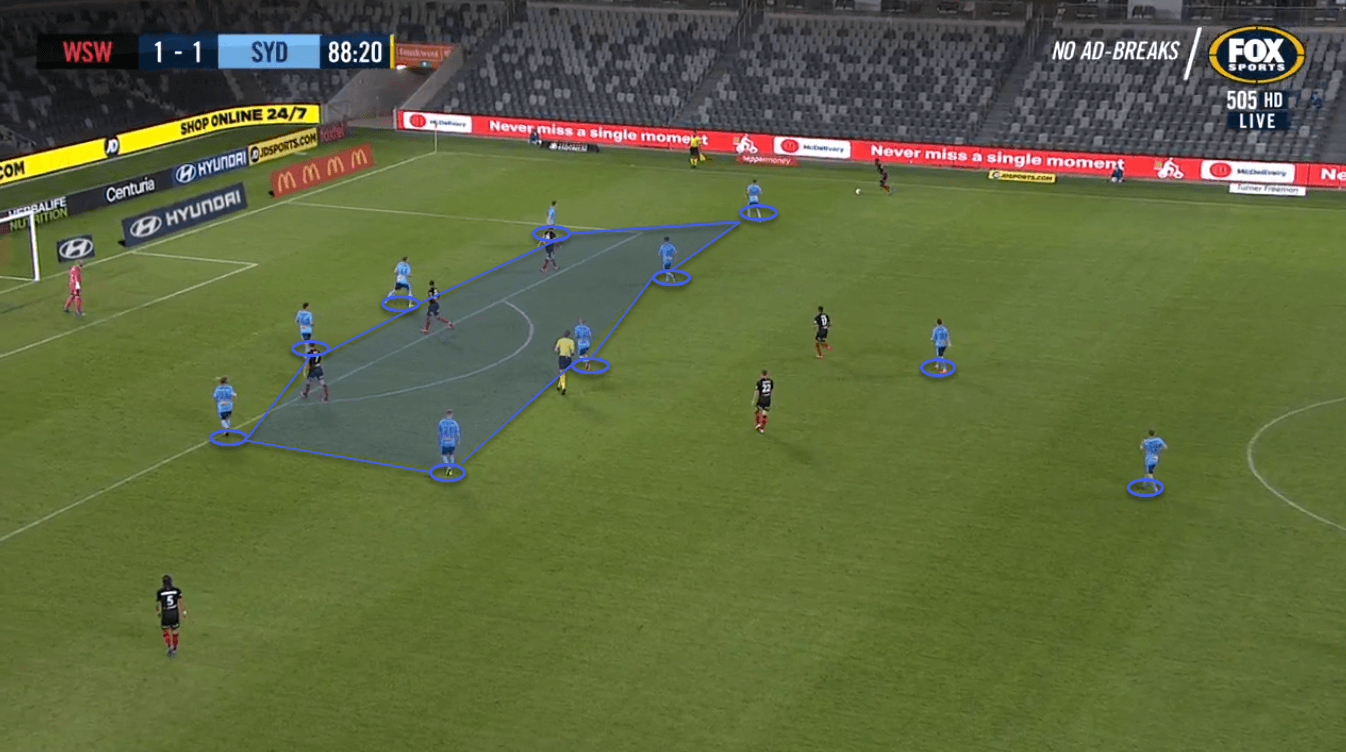
Transitions
Corica’s positional style favors the defensive transitions when losing the ball in the final third. As aforementioned, the Sky Blues will progress the ball through the thirds with the whole team advancing, arriving at the last thirds with numbers. This offensive style allows the Sky Blues to be prepared when the ball is lost to counter-press and recover the ball as soon as possible. In the next picture, we can see the moment they lost the ball in the final third, with two players pressuring the ball carrier. Instead of retreating to cover backspaces, the closest players to the ball quickly react to win the ball back in the first seconds of pressure, highlighting the aggressive and offensive mindset of the team.
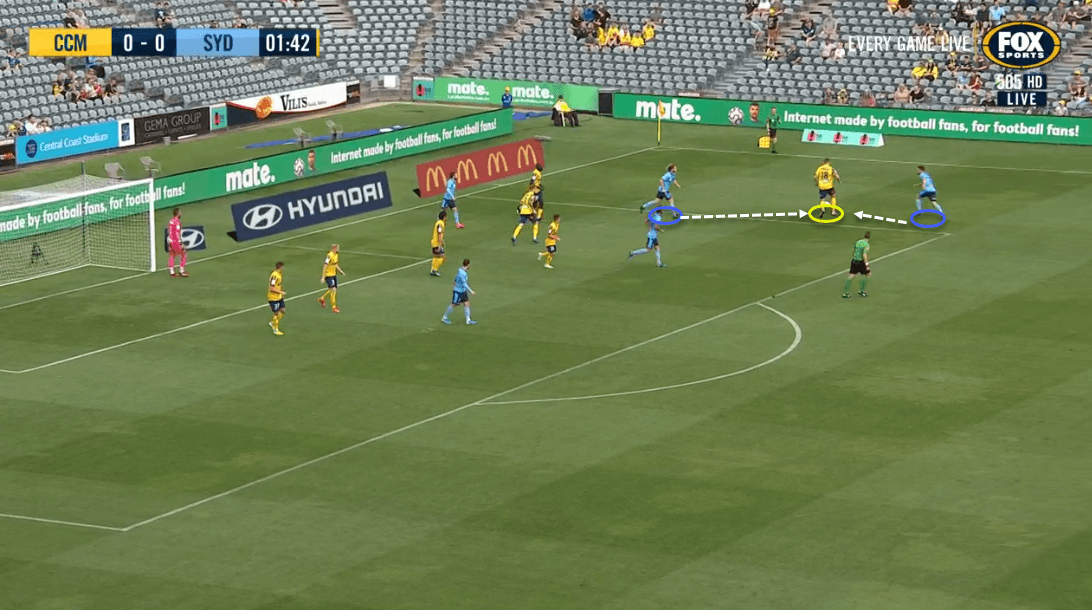
Corica’s aggressive defensive transition to recover the ball as high as possible in the final third does not compromise their defensive cover, only conceding one goal from counter-attacks in the whole season. The centre-halves will keep a high line and will receive the support of the two pivots who will sit in front of them. In this way, the Sky Blues use a rest-defense of four players as depicted in the following picture, which allows them to be well prepared to control the central areas in case of a counter-attack, delaying the attack for the whole team to retreat.
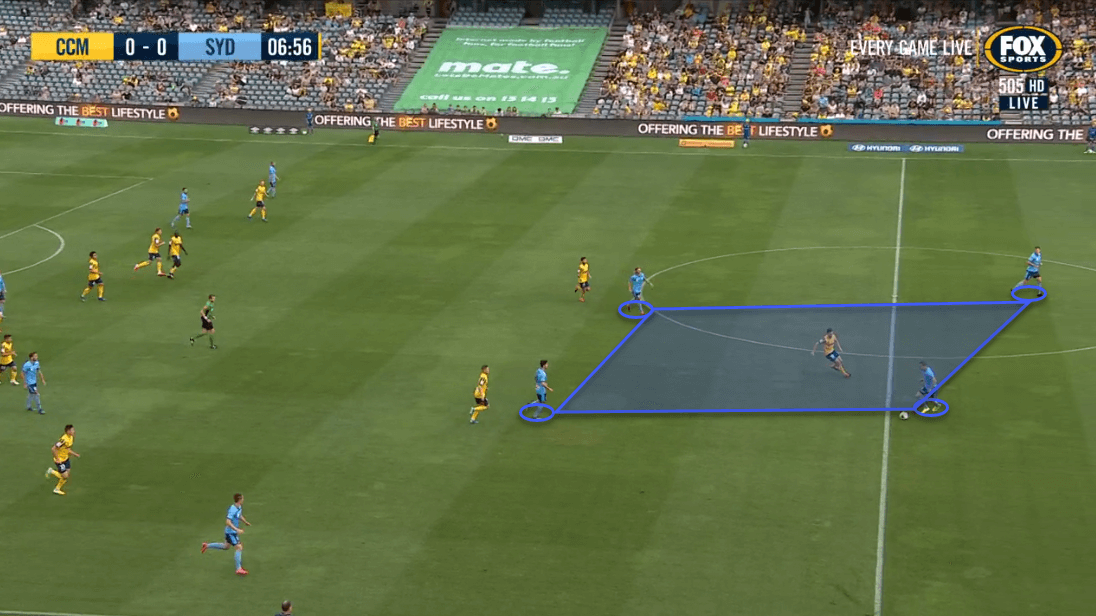
Last but not least, we have seen four goals scored in this season by quick counter-attacks flawlessly performed with a fast offensive transition. In the next picture, we can see a goal on a counter-attack against Melbourne Victory. After recovering the ball in the central area, the first pass is out of pressure to the right flank. At this moment, they launched the counter-attack, with a perfect off the ball movement of the front two with decoy runs in opposite directions to open up the central channel. The full-back exploited that space, underlapping the advanced midfielder, and collecting the ball behind the lines to assist the centre-forward. This situation reflects how Corica’s high-intensity counter-attack works, with the first pass out of pressure, and the front two running in behind the defensive line stretching it, creating space for the forward runs of the defensive or midfield lines.
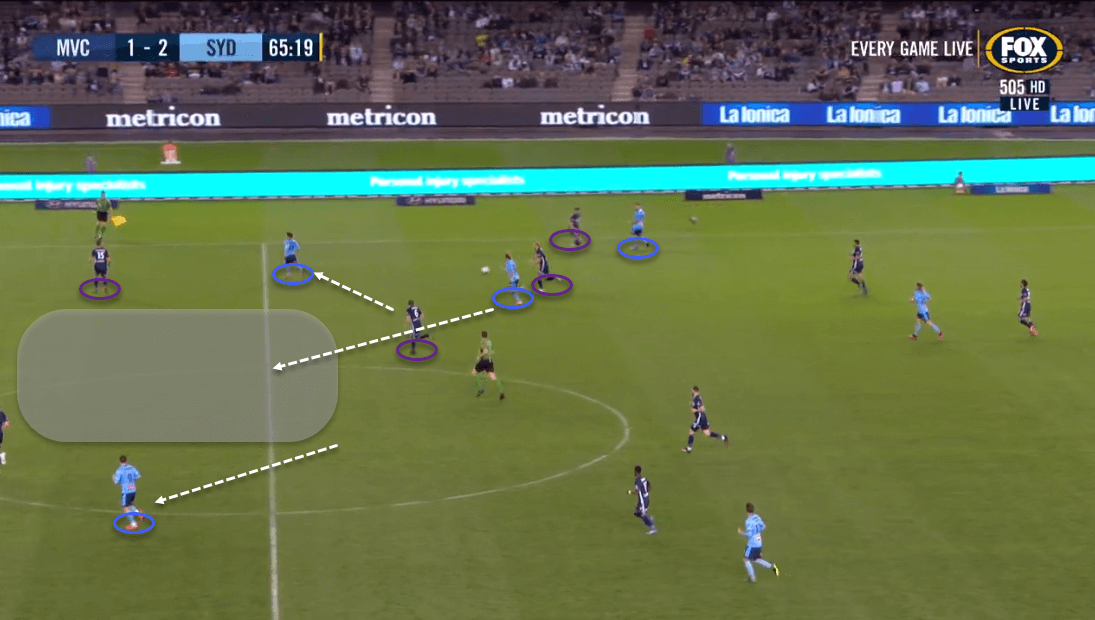
Conclusion
We have gone through an in-depth analysis of Steve Corica’s style, which has given Sydney FC tremendous outcomes winning two Premier silverwares and in the run for a back-to-back A-League championship, only achieved by Brisbane Roar FC in 2010-11 and 2011-12 seasons.
The variety of movements and rotations to progress the ball in their offensive 4-2-2-2 shape gives this coach a positional style. The full-backs gain a significant role in his attacking philosophy as we see in coaches of the caliber of Pep Guardiola and Jürgen Klopp in Manchester City and Liverpool, respectively. At the same time, when defending the Sky Blues has become the best team of the A-League conceding less than one goal per match, reinforcing the quality of the coach in his compact style of defending.

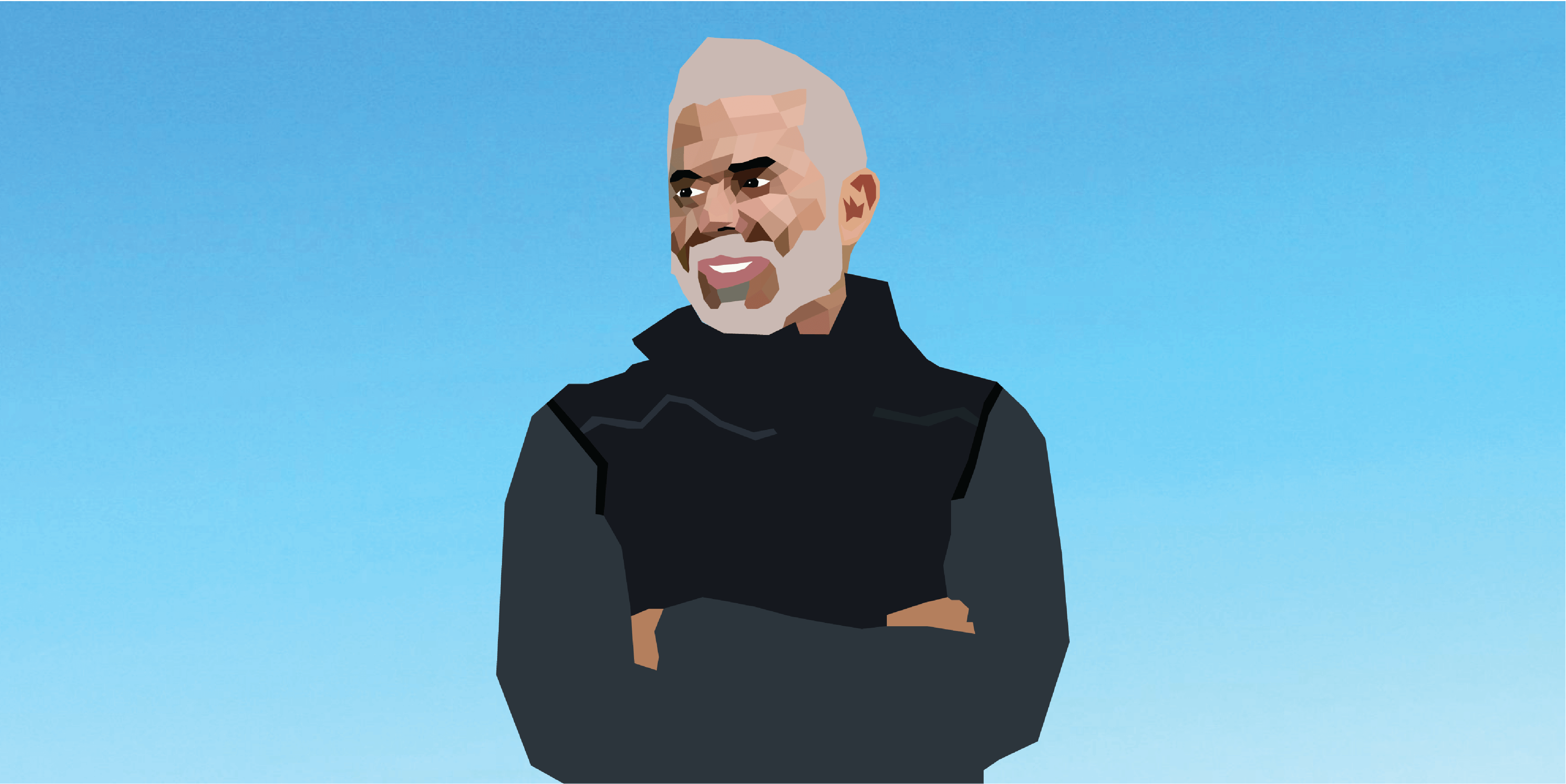



Comments